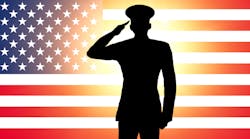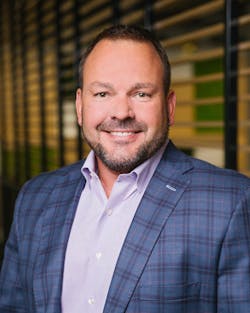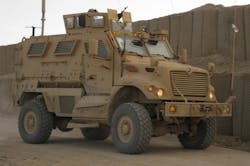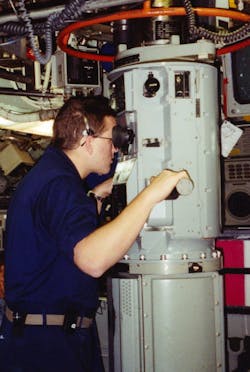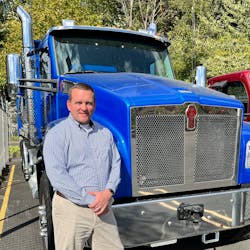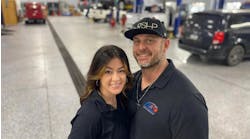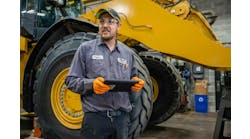The military ain’t for everybody, but for those suited, the training and experiences veterans have picked up during their service is never put aside. Fleet Maintenance spoke with three veterans who, as commissioned officers, learned valuable lessons and behaviors they apply every day as leaders in various high-level roles working to develop the latest trucks and trailers the industry relies on.
Brent Yeagy, President and CEO, Wabash
Military service: Ensign, United States Navy
Brent Yeagy was a chemical engineering major at Purdue University when the awesome power of America’s arsenal was unleashed on Iraq during Operation Desert Storm in response to the invasion of Kuwait.
“I watched the first Gulf War happen in my living room,” recalled Yeagy of the 42-day bombardment in early 1991. “And then I enlisted in June when second semester was over.”
The recruiter pushed Yeagy into becoming a nuclear reactor operator, who thought that “sounded awesome.”
“I tell people all the time it was the best decision I ever made in my life,” Yeagy asserted. “It gave me tremendous purpose that was lacking in my first couple years of Purdue, and really gave me an appreciation for leadership.”
“I was bailing water up to my head, and I'm swimming in it, and people are screaming at me, and things are going off—and we failed,” Yeagy recalled.
Yeagy did not realize at the time no one really beats the terrestrial naval version of Star Trek’s Kobayashi Maru, where the point is to make the students lose. Following the test, the senior chief running the exercise imparted some important words Yeagy never forgot: “You’ve got to learn how to fail.”
Those words after this “humbling experience” made more sense as Yeagy’s career advanced.
“You don't really understand that at the time, but then as your career moves on and you see different things, you start understanding what that means; how to manage the stress, how to manage the ambiguity, how to work through the uncertainty, how to trust the process, and see through the fog,” he explained.
Yeagy hurt his knee and spent his abbreviated sea duty as a line officer testing equipment during submarines’ sea trials and finished as an ensign. But that one lesson in failure, which he called “a little crucible,” continues to inform him as president and CEO of Wabash, one the largest trailer and truck body manufacturers.
Read more: To win the supply chain war, just call in the cavalry
In the past few years, Yeagy had to contend with a new unwinnable situation—the COVID-19 pandemic—and he appreciated those senior chief’s words even more as he had to lead his organization and its 6,000 employees through “ridiculous change” and places they may not have wanted to go.
“Because they’re living in that same world where you’ve got to fail a little bit, you’re going to have to be uncomfortable; you’re not going to know exactly how this is going to turn out,” Yeagy said. “You’ve got to trust that people around you see the bigger picture than you in the moment.”
Looking at that bigger picture, Wabash announced record quarterly revenue and earnings per share.
Another lesson Yeagy shared came from a captain who taught him about the value of decentralized command and how it can help you as a leader.
“You’ve got to trust that the talent,” Yeagy offered. “You’ve done the work to put in the right talent that’s highly trained with a common mission. And when you do that, you can roll through periods of ambiguity, and stress, and uncertainty, and still keep everything going in the same relative direction.”
Yeagy’s time in nuclear power school, and as an instructor right after, taught him that success is great, but repeated success is far more important. You can’t just succeed at powering the reactor up before the mooring lines are cast off—it needs to work several hundred feet underwater, thousands of miles away from port, and for possibly months at a time. And aircraft, ships, and other subs may be attacking you and there could be a fire. This is not likely, but subs drill for these events weekly to ensure repeated success is a reflex, not a conscious thought.
“Some people get enamored with what has been done, and they’ll make that 80% of what they see,” Yeagy said. “I’m 51% how you do it, and 49% what you did. I might even be more on the ‘how you did it’ because the ‘how’ tells me if it’s repeatable. Can I predict it will happen good again or not? Or, was it a random success? I want continued success.”
Yeagy offered one last point on managing people, learned from another senior chief while at prototype, the practical stage of nuke school: “Don’t order them; that doesn’t enable them. You need to coach them.”
“They’re going to have to trust you,” Yeagy recalled the chief imparting. “If they trust you, you’ll be able to tell them what to do when they need to do it. When the time comes, they will follow you.”
Brad Watson, VP of program management and operations strategy, Navistar
Military service: Captain, United States Marine Corps
When America was attacked on September 11, 2001, Brad Watson was in Washington D.C., not too far from the Pentagon. The current VP of program management and operations strategy for Navistar was working as an associate producer for the CNN show “Late Edition with Wolf Blitzer.” That horrific day was a call to action for Watson, who signed up for a commission in the U.S. Marine Corps the next month. He wouldn’t officially start officer training until the next October due to so many others answering that same call to action.
Once he got through training and landed in Iraq’s Al-Anbar province, action was never in short supply. During 15 months of urban combat operations between 2004 and 2006, Watson was wounded by improvised explosive devices (IEDs) three times. The final one was the most life changing. That’s chiefly because of how the Humvee the 1st lieutenant was in looked after the IED exploded—like a crumpled ball of jagged steel. There should’ve been no way he survived. And after that close call in Ramadi, Watson received a new call to action—literally.
“I got a phone call [from Navistar],” Watson recalled. “They said, ‘Would you like to come and be the program manager for a vehicle that survives roadside bomb blasts?’”
Watson knew he was the perfect marine for the job working on the Navistar Defense’s MaxxPro Mine Resistant Ambush Protected vehicle. The innards are similar to a Navistar’s International HV, though with an exterior covered in armor plating and blast shielding technology.
Watson says the culture of Navistar makes him feel right at home.
“The work ethic that we have here resonates with veterans; the fact that we’re willing to go the extra mile and we have the grit to get it done,” Watson explained. “That was something that I said, ‘Yeah, that’s a good fit here.’”
Navistar’s performance-driven culture matched Watson’s hunger for continuous improvement, and he wants as much intel as possible—good or bad.
“Veterans tend to be unintimidated by measures of performance,” he said. “At Navistar, we measure ourselves to metrics and quantifiable goals we set, and veterans have the drive to achieve those.”
He also noted that teamwork is a huge component of the Lisle, Illinois-based truck manufacturer.
“One of our cultural norms is to put differences aside and get the job done,” he said. “That’s another thing that I think veterans can relate to. People have a drive, a willingness, a desire to succeed and make sacrifice here that is, frankly, a little bit inspiring.”
Because he and his platoon relied on a fleet of armored vehicles in in Iraq, Watson also acknowledged the importance of uptime.
“Your life really depends on them in combat, and you have to keep them operating—you have to have them up,” Watson said.
That carries over to the design and manufacturing of Navistar’s commercial vehicles.
“Everything we do from initial design through launch, uptime is top of mind for me,” he said. “What I’m doing today relates directly back to my experience in the Marines.”
Living a life of honor, courage, and commitment drives any good marine, and Watson knows he has to be the moral compass of his new team. As such, he is the president of Navistar’s internal employee resource group, Military Veterans at Navistar (MVAN).
“It’s a community of veterans where they can come together and share ideas, seek support, and just feel the camaraderie that maybe sometimes we all miss a little bit,” Watson surmised.
Mark Buckner, battery electric vehicles section manager, Kenworth Trucks
Military service: Junior officer, Submarine Service, United States Navy; Captain (O-6) United States Naval Reserve
Mark Buckner made the decision to join the military in the relative peace of the mid 1990s and headed to Carnegie Mellon University in 1997 under the Reserve Officers’ Training Corps program. After graduation, and an arduous training stint that included submarine school and Nuclear Power School, Buckner received his orders to the fast-attack sub USS Boise (SSN-764) in Norfolk, Virginia. A year later, the junior officer was submerged in the Red Sea, helping ensure the safe operation and maintenance of the boat’s reactor as it participated in the shock and awe portion of Operation Iraqi Freedom.
After leaving active duty in 2008, Buckner worked at Fluke Corp. as a service engineer, helping design and implement various calibration and diagnostic devices, tools used often by technicians on both subs and in vehicle shops. After leaving the Boise, the shore duty-bound Buckner left for Bangor, Washington, to help manage the mooring, arrival, and departures of the ballistic missile subs, or boomers, at Naval Base Kitsap. Each one has the power to level two dozen cities, and their transit to and from the Pacific requires the raising of the Hood Canal Bridge, which Buckner also needed to arrange.
He stayed on as a reservist, and because the Navy wasn’t quite ready to give him up, the submariner was ordered to Kabul.
“We were trying to get the Afghans and Pakistanis and NATO to share operational intelligence information,” Capt. Buckner recalled.
At the end of 2018, Buckner left Fluke for Kenworth Trucks, working out of the Kirkland headquarters. There he led the team that created the Class 8 T680 Next Gen’s fairing design, which along with other aerodynamic improvements, increased the model’s fuel efficiency by 6%. Now, as battery electric vehicles section manager, he is working to scale the manufacturing and speed the production time of Kenworth’s medium- and heavy-duty zero-emissions trucks. The T680e is currently in low-volume production.
The version in development is “expected to be a much higher volume and come with a lot more performance and capability,” Buckner teased.
The optics might convey that this role is less vital than his previous roles, but Buckner attacks the job as he would any of his military duties, as government regulations demand reductions in commercial vehicle emissions and the nation’s economy rests on its ability to transport goods.
“It’s critical we have a good product and get it out there on time, but it also has to meet the customer requirements, both in range and reliability and performance,” Buckner said, adding that delivering the product also affects the company and its customers’ environmental impact.
All this may seem like a lot of pressure, but Buckner’s past has prepared him.
“I always tell people around here, ‘Nobody’s shooting at me. Nobody’s asking me to sleep at work every night or every other night, right?’” he said. “This is not stressful. There are definitely challenges, though.”
One of those challenges is building up his direct reports.
“Sometimes even more challenging than a stressful, high combat, endurance environment is getting those people to have that self-growth,” Buckner admitted.
He learned long ago that raising the people under you to new heights is its own reward.
“There’s a switch that I always love to see, especially in first-class petty officers, when I know they’re ready for the for the chief anchors,” Buckner explained. The big change is when these E-6’s—the military equivalent to middle management—stop thinking about what time their shift will end and start contemplating how they can improve to benefit the team.”
This insight has carried over into Buckner’s civilian life.
“Seeing design engineers grow into project engineers and grow into managers: that’s what drives me,” Buckner concluded.
